Did you know some tanks have armor so thick, even the strongest military ammo can’t go through? For example, the T95 tank destroyer has armor up front that’s about 305 mm thick. This makes it hard for most rounds to hit it. With warfare evolving and new ammo being made, I want to look into a big question: can .50 caliber armor piercing rounds stop a tank? This question shows us how .50 caliber rounds work, their strength, and their history in the military.
In this article, we’ll look at how .50 caliber armor piercing ammo is made and how well it works against different tanks. We’ll compare specs, look at real-world use, and give a full military ammunition review. This will show us just how powerful these rounds are.
Key Takeaways
- The T95 tank’s frontal armor is about 305 mm thick, making it tough for most ammo to penetrate.
- Knowing how .50 caliber rounds are made helps us understand their ability to pierce armor.
- Ballistic performance changes a lot depending on the tank and its armor.
- The past success of armor piercing ammo helps shape today’s military tactics.
- Looking at how .50 caliber rounds are used in real situations helps us understand their role in both military and law enforcement.
Understanding the .50 Caliber Ammunition
The .50 caliber ammunition is a key player in both military and civilian use. It’s known for its strong ballistic performance. It’s used in many situations, from law enforcement to military operations. There are different types, like standard and armor-piercing rounds.
Looking at the .50 caliber, we see its design is quite specific. The armor-piercing type has a hard core to go through armor easily. This is different from the standard type, made for long-range shooting. These differences change how the ammo works and its effects, like speed, weight, and impact energy.
Standard .50 caliber ammo shoots over 2,800 feet per second and packs about 13,000 foot-pounds of energy. These numbers are key to its performance. If you’re into gear for shooting, you might find this interesting: essential gear for shooters.
This ammo is versatile and works well in many situations. It’s a top pick for those who need it. Its high speed and energy make it stand out in real situations, proving its worth to military and law enforcement.
Historical Context of Armor-Piercing Rounds
The story of armor-piercing rounds is closely linked to the growth of military technology and weapons. These special bullets came about because of the need to break through the tough armor of vehicles and strongholds in battles.
During World War I, armor-piercing shells became a key innovation in artillery. They were made to hit armored vehicles. As the war went on, military bullets changed a lot to meet the needs of the battlefield.
In World War II, armor-piercing rounds got even better. The need for good anti-tank weapons led to new ideas in design and materials. Important steps forward included high-speed bullets with hard tips made from tungsten or steel. These tips helped the bullets go through armor better.
- Effective Use: Military forces used different kinds of armor-piercing rounds, like solid-cast and sabot rounds.
- Increased Penetration: Designers worked hard to make bullets that could go through thick armor, like the Pz.Kpfw. VIII Maus.
- Technological Change: Over the years, new materials science helped make better rounds.
Learning about the history of armor-piercing rounds helps us see how military strategies and armor penetration have changed over time. Each big war has pushed the development of military bullets, showing the constant competition between offense and defense.
Types of Tanks and Their Armor Characteristics
Knowing about tank types and their armor is key to understanding modern military vehicles. Tanks are sorted by their roles, like main battle tanks, light tanks, and support vehicles. Each type has armor designed to face different threats on the battlefield.
Main battle tanks like the M1 Abrams and Leopard 2 are made for the front lines. The M1 Abrams has advanced composite armor, great against kinetic threats. The Leopard 2, especially the Leopard 2PL, has more turret protection, taking on high-powered shells.
Light tanks, such as the VIDAR, focus on speed over heavy armor. It has armor from 10mm to 40mm, protecting against small ammo but not kinetic shells. Its design lets it move fast, perfect for quick moves and flanking during battles.
The T-14 Armata is a leap in armor tech. It has protection up to STANAG 4569 Level 5 and uses active and passive defenses. This tank can take on threats with its 125mm gun and has an Active Protection System (APS) to stop incoming fire, boosting its defense.
- The M1 Abrams features composite armor with high resistance to various threats.
- The Leopard 2PL incorporates modern upgrades that enhance turret survivability.
- The VIDAR prioritizes speed, with armor able to deflect moderate caliber fire.
- The T-14 Armata combines traditional armor with cutting-edge APS technology.
Understanding the different tanks and their armor gives us deep insights into their strengths and weaknesses. This knowledge is crucial for military planners and fans, especially when armored defense is key in battles. For more on military strategies, check out this link.
Can .50 Caliber Rounds Penetrate Tank Armor?
Looking into .50 caliber rounds, we see if they can go through modern tank armor. Their success depends on the tank’s specs and the ammo type. Let’s dive into how today’s tanks are armored and how .50 caliber compares to other ammo.
Specifications of Modern Tanks
Today’s tanks have armor that’s layered and varies by model. For instance, the R3 T20 FA-HS can take a .50 caliber hit from the front but isn’t safe against bigger guns. On the other hand, the Sd.Kfz.234/2 has armor that protects from different angles.
What affects how well tank armor holds up includes:
- Turret rotation speed, which can be as fast as 8.3°/s to 55°/s, helping in quick responses.
- Armor thickness, with some tanks having layers strong against armor-piercing rounds.
- Mobility, like the R3’s 125 km/h speed, allowing fast moves but risking tip-overs when turning sharply.
Comparative Analysis with Other Rounds
When comparing .50 caliber to other ammo, we see big differences in how well they go through armor. .50 caliber can hit lighter armor but struggles with heavy tanks. In contrast, the 20 mm Oerlikon cannon’s rounds can go through 6 mm to 57 mm of armor, giving it an edge in battles.
The 50 mm KwK39/1 cannon in the Sd.Kfz.234/2 also beats .50 caliber in penetration. It can shoot APC shells up to 106 mm deep at close range.
This look at modern tanks and ammo shows .50 caliber rounds can damage but don’t always go through armor. They’re less effective against advanced weapons. Knowing this is key for military planners and fans.
Ammunition, Bullets, Ammo, Ammo & Bullets, Ammunition Review
Various types of ammunition play a big role in military and law enforcement. In my review, I look at different calibers and how they perform. The 9mm caliber is widely used and has unique traits that affect how it compares to other bullets.
- Penetration capabilities: How deep a round goes into a target shows its effectiveness.
- Stability: A stable bullet stays on course, making it more accurate at a distance.
- Overall reliability: It must work well in different situations for serious use.
The Prodigy 9mm is a standout with a capacity of 17+1 to 20+1 rounds. Its 4.25-inch barrel helps it hit its mark with an average accuracy of .907 inches. After firing about 500 rounds, it’s proven reliable, hitting 8- to 12-inch steel targets from 50 yards.
Knowing how ammunition performs is key, especially when choosing the right ammo for practice or combat. Every decision, whether for a quick shoot or serious law enforcement, depends on the right bullets. For more on training with specific ammunition, see this detailed guide on ammunition usage and practices.
Real-World Applications: Military and Law Enforcement
.50 caliber ammunition is key in both military and law enforcement. It’s perfect for training and defense because of its design and power. As the need for reliable ammo grows, .50 caliber rounds are a top choice.
Use in Target Practice and Defense Scenarios
Target shooting is crucial for military and police training. .50 caliber rounds are great for improving shooting skills. They also boost defensive power in critical situations.
People in the field praise .50 caliber ammo for its real-world benefits. It’s vital for overcoming accuracy and reliability issues in high-pressure situations. Military testing ensures these rounds are up to the task of evolving defense tactics.
- Versatile use in various military applications.
- Enhanced accuracy during target shooting training.
- Critical in shaping effective defense strategies.
Exploring ammunition further shows how crucial the right choice is for success in law enforcement and the military. .50 caliber ammo is essential in these fields. For more on the impact of weapons in conflict and defense, check out the history of the AK-47. It’s a symbol of reliability and effectiveness.
Alternative Ammunition for Armor Penetration
Looking into different ammo types is key for those aiming for better armor penetration. While .50 caliber rounds are common, there are other options that bring special benefits. These are great for fighting modern armor.
The 5.56 NATO cartridge is one such option. It’s based on the .223 Remington but has been made stronger for better penetration. With rounds like Winchester’s 62-grain M855 and Hornady Black 62gr FMJ, it can shoot at 3060 fps and hit with 1289 ft/lb of force. This shows it could be a good choice for piercing armor.
Another good choice is the 300 AAC Blackout. It’s great for close fights, especially with fast 110-grain bullets that can hit 2,400 fps. These rounds are interesting for taking on armored targets.
- 5.56 NATO FMJ bolts – known for their speed and how they behave on impact.
- 300 Blackout subsonic rounds – good for quiet operations.
- Advanced armor-piercing projectiles designed for precise hits.
Choosing the right ammo can really change the outcome of a mission. Looking into these alternatives shows how important it is to know what you’re choosing. For a deeper look at ammo laws and policies, check out the details in related legislation. This can help with making smart ammo choices.
Conclusion
In reviewing the summary of findings, it’s clear that .50 caliber armor-piercing rounds have a rich history and have evolved over time. However, their effectiveness against modern tanks is complex. These rounds can cause significant damage, but today’s tank armor often makes them less effective in real battles.
The ammunition effectiveness of .50 caliber rounds is tested in urban warfare, where new tank armor and protective tech pose challenges. As military tactics change, using just these rounds may not be enough to beat armored vehicles. This affects both military and civilian defense strategies.
Looking at the tank penetration analysis, it’s clear that ammo technology is always evolving. This evolution changes how we fight and defend. Knowing the limits and strengths of different munitions is key for future battles. For more on weapon safety and guidelines, check out this resource.











